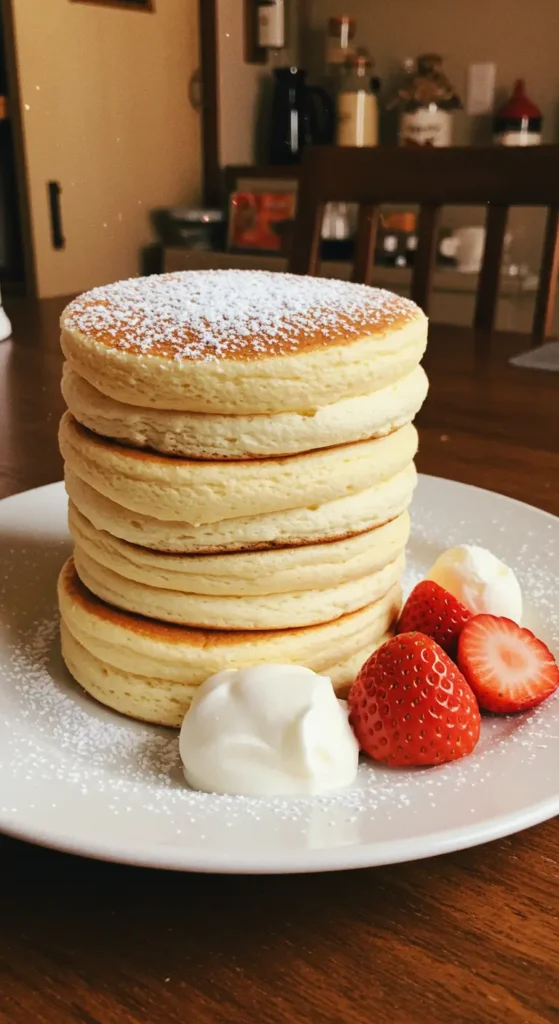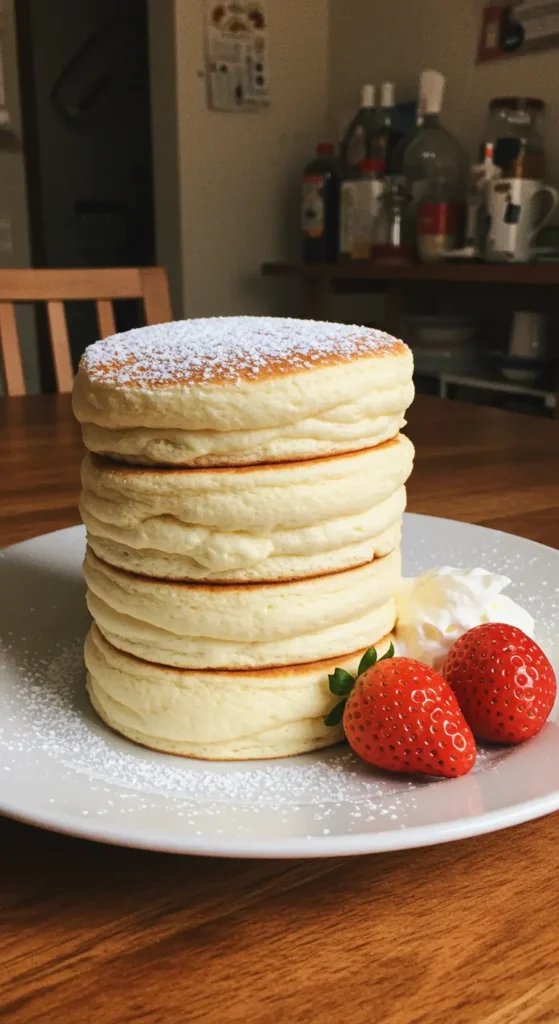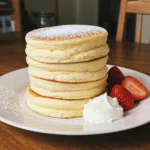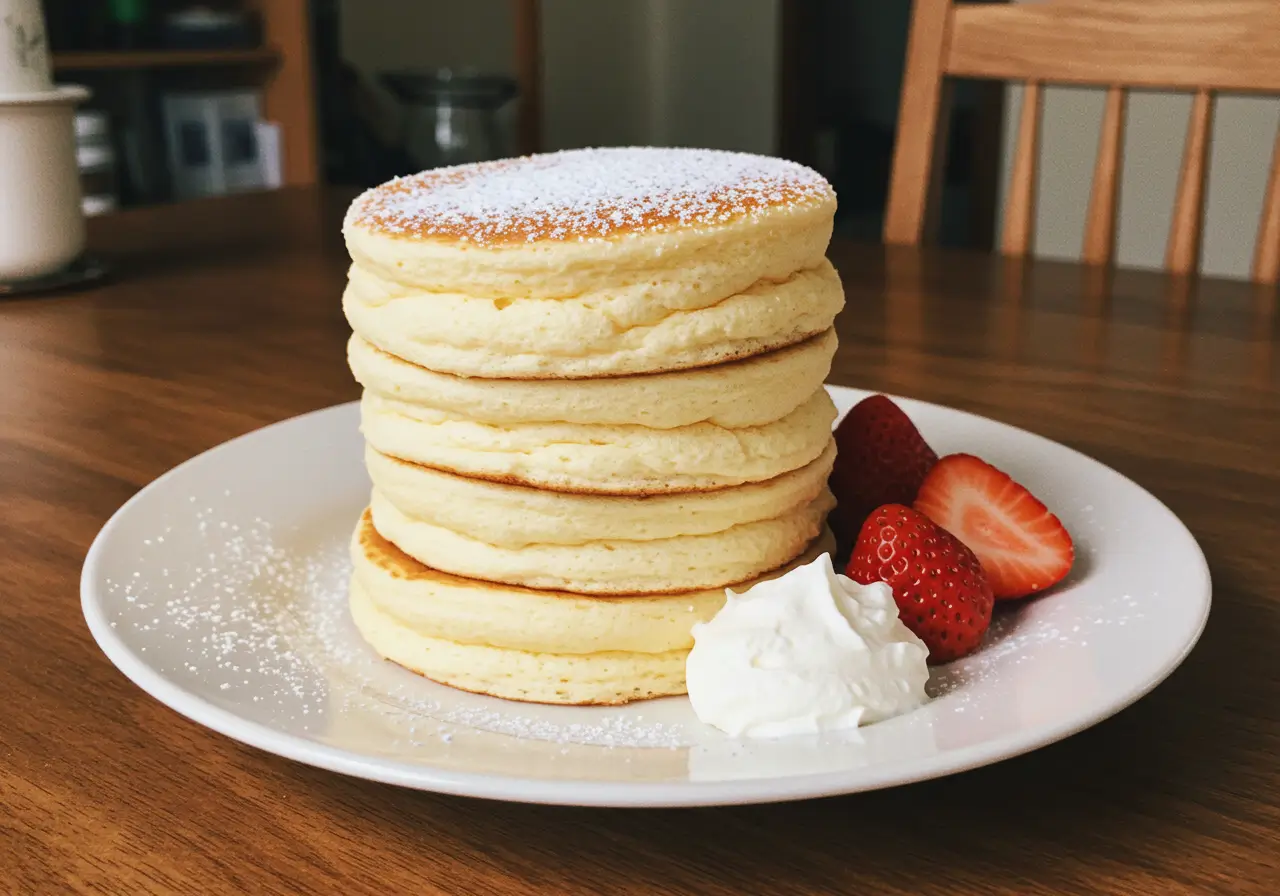Japanese Souffle Pancake
Table of Contents
Soft, jiggly, and towering like a cloud on your plate — the Japanese Souffle Pancake is a charming twist on your usual breakfast. This guide peels back the layers (and fluff) of this viral treat. From its origins and unique ingredients to its mesmerizing cooking techniques, you’ll learn how to recreate this dreamy dessert-like pancake in your own kitchen.
We’ll also dive into the science behind the rise, expert tips to avoid collapse, and why these pancakes have taken social media — and brunch tables — by storm. Whether you’re a pancake lover, a curious cook, or just craving something extra fluffy, you’re in the right place.
So, grab your whisk, prep your patience, and let’s explore the world of Japanese Souffle Pancakes from top to bottom.
Ingredients that Make the Fluff

Essential Ingredients in Souffle Pancakes
Let’s get this out of the way — not all pancakes are created equal. The secret behind the irresistible texture of a Japanese Souffle Pancake lies in a few specific ingredients. While they look simple, each one has a big job to do. You’ll need:
- Eggs (separated) — the whites get whipped into a glossy meringue
- Cake flour — gives the pancakes that soft, delicate crumb
- Whole milk — adds richness and moisture
- Sugar — for a slight sweetness and meringue stability
- Baking powder — to lift things up just a little more
- Vanilla extract — for a hint of aroma (opt for alcohol-free if needed)
No need to go hunting for fancy stuff — these are everyday staples with a magic twist when used right.
Why Cake Flour, Not All-Purpose?
Now, here’s the kicker — using cake flour makes all the difference. It’s lighter and lower in protein than regular all-purpose flour, which means your pancakes won’t be tough or dense. If you substitute it with something heavier, you might end up with a chewy flop instead of a cloud-like bite. So, don’t skip this one!
The Science Behind the Fluff
Meringue Magic: How Stiff Peaks Create Height
Ever wonder what makes a Japanese Souffle Pancake rise so tall? It’s all thanks to meringue — whipped egg whites that trap air like little balloons. When folded gently into the batter, they give your pancakes their signature puff. But here’s the deal: they need to be whipped until stiff peaks form.
That means when you lift your whisk, the peaks should stand tall and firm, not droop. Underwhipped whites will fall flat. Overwhipped ones? They’ll break apart when mixed. The trick is to stop just when they’re glossy and strong. It’s part science, part intuition.
Steam Cooking Explained: Why It’s Crucial
Now that your batter’s loaded with air, how do you keep it from collapsing? Say hello to steam cooking. Adding a splash of water to the pan and covering it with a lid creates steam, which cooks the pancakes gently and evenly. This humid environment helps firm up the outside without drying it out or burning the bottom.
Unlike regular flapjacks, which sizzle on high heat, these beauties thrive low and slow. The steam helps the pancake rise up, not out. Without it, you risk burning the bottom while the middle stays raw. Trust the steam — it’s your pancake’s best friend.
Step-by-Step Cooking Guide

Preparing the Batter Like a Pro
First things first — separate your eggs while they’re cold, then let them sit to reach room temperature. This helps with both yolk mixing and better meringue volume. In one bowl, whisk the yolks with milk and vanilla extract until the mixture becomes pale and slightly frothy. Sift in your cake flour and baking powder, and whisk gently. The goal? A smooth, thick batter without overworking it.
Now, beat the egg whites until foamy, then add sugar in thirds. Keep beating until you get stiff peaks — the meringue should be glossy, stand tall, and hold its shape. Don’t rush this step; it’s the backbone of your Japanese Souffle Pancake‘s height.
Time to fold! Add a scoop of meringue into the yolk batter and fold gently to loosen it. Then, add the rest in two parts. Fold slowly with a hand whisk or spatula — you want to mix, not deflate!
Cooking and Flipping Without Collapse
Preheat a nonstick skillet or cast iron pan on low heat. Lightly grease the surface and get ready for magic. Using a cookie scoop or spoon, mound 2–3 scoops of batter per pancake, one on top of the other.
Add a tablespoon of water to the pan (not on the batter!) and immediately cover with a lid. The steam is essential. Cook for 5–7 minutes, then gently add another scoop on top and re-cover. Patience is key here.
To flip, use an offset spatula and a “roll-over” motion. Flip with love — not force — or you’ll squash the fluff. Add a bit more water and steam again for 4–5 minutes.
Voilà! Serve warm, and prepare to impress.
For more delicious recipes, check out our waffle recipe — a great brunch companion!
Common Mistakes and Fixes
Why Your Pancakes Deflated
Let’s face it — these pancakes can be a little fussy. One wrong move and your tall, airy Japanese Souffle Pancake might flatten like a popped balloon. But don’t panic, because there’s always a fix.
Deflation often starts with under-whipped or over-whipped meringue. If the peaks don’t hold or your whites look grainy, the structure won’t last. Always aim for stiff, shiny peaks that fold without resistance.
Another culprit? Flipping too early. If the bottom isn’t golden and the sides haven’t set, the pancakes won’t survive the flip. Use the “gentle wiggle” test — if they move without sticking, they’re ready.
How to Avoid Egg White and Heat Mistakes
Be sure your tools are clean and grease-free when whipping egg whites. A little yolk or oil ruins everything. It might seem minor, but it’s a pancake killer.
Also, never cook on high heat. These pancakes need low and slow — like a Sunday morning. Rushing the heat cooks the outside too fast while leaving the inside raw. That’s a recipe for disaster.
Get these basics right, and your souffle stack will bounce with pride!
Best Toppings for Japanese Souffle Pancakes
Fresh Fruits, Syrups, and Whipped Cream
Once your Japanese Souffle Pancake is golden and stacked like a tower, the real fun begins — toppings! The classics never fail: dust them with powdered sugar, drizzle with maple syrup, and crown them with a dollop of fresh whipped cream.
Want to go a little extra? Add a handful of sliced strawberries, blueberries, or bananas. Not only do they add sweetness, but they also create a stunning color contrast. That’s an Instagram win right there!
Japanese-Inspired Toppings and Plating
For a twist that nods to its roots, top your pancakes with azuki beans (sweet red beans) or a spoonful of matcha whipped cream. If you’re feeling adventurous, drizzle kuromitsu, a rich Japanese black sugar syrup, instead of regular maple.
Want cafe vibes at home? Plate with precision. Use a ring mold for whipped cream or stack berries neatly. Presentation matters when your pancakes look like art.
Serving Ideas & Occasions
Brunch, Birthdays, or Dessert Time
There’s no wrong time to serve a Japanese Souffle Pancake. Thanks to their light texture and cake-like flavor, they fit in anywhere — whether you’re throwing a fancy brunch or planning a cozy birthday breakfast.
They’re also perfect for dessert. Add ice cream or a drizzle of chocolate sauce, and they instantly shift from breakfast to an after-dinner showstopper. Don’t be surprised if guests ask for seconds!
Pairing with Beverages and Vibes
To elevate the experience, pair your pancakes with a soothing drink. A warm matcha latte balances the sweetness beautifully, while an iced hojicha brings a nutty, roasted flavor. If you’re keeping things simple, a classic cup of milk or coffee works just fine too.
Set the scene with a clean plate, pretty garnishes, and maybe even some lo-fi music. Before you know it, you’ll have your own Japanese pancake café — right at home.
Japanese Souffle Pancakes Around the World
Popular Cafes Known for Souffle Pancakes
The Japanese Souffle Pancake has gone global — and for good reason. Its dreamy rise and jiggly charm make it a favorite on café menus everywhere. In Japan, you’ll find lines outside spots like Flippers and A Happy Pancake, both known for their cloud-like stacks.
In cities like Los Angeles, London, and Sydney, trendy bakeries and dessert cafés have added their own spin. Some add mochi inside, others stuff them with custard — each version offering something fresh while staying true to the fluff.
Global Adaptations and Online Buzz
Beyond the cafes, social media played a huge role in the pancake’s rise. Just one slow-motion jiggle on TikTok or Instagram, and everyone wants to make their own Japanese Souffle Pancake.
Even home cooks have put twists on the recipe, swapping in dairy-free milks or turning them into mini cakes. The world may speak different languages, but a fluffy pancake? That’s universal.
Print
Japanese Souffle Pancake
- Total Time: PT30M
- Yield: Serves 3
- Diet: Vegetarian
Description
These fluffy Japanese Souffle Pancakes are tall, airy, and melt-in-your-mouth soft. Perfect for breakfast or dessert, they’re made by folding whipped egg whites into a delicate batter and cooking low and slow with steam for the ultimate cloud-like texture. Topped with whipped cream, fresh berries, and syrup, they bring a taste of Japanese café culture to your kitchen.
Ingredients
- 2 large eggs (separated)
- 1½ tablespoons whole milk
- ¼ teaspoon vanilla extract
- ¼ cup cake flour
- ½ teaspoon baking powder
- 2 tablespoons sugar
- 1 tablespoon neutral oil (for greasing pan)
- 2 tablespoons water (for steaming)
- ½ cup heavy whipping cream (optional, for topping)
- 1½ tablespoons sugar (for whipped cream)
- Fresh berries (e.g., strawberries, blueberries)
- 1 tablespoon powdered sugar (for garnish)
- Maple syrup (for serving)
Instructions
- Separate the eggs and place the egg whites in the freezer for 15 minutes.
- In a bowl, whisk together egg yolks, milk, and vanilla extract until frothy.
- Sift in cake flour and baking powder, then gently mix to combine.
- In a clean bowl, beat the chilled egg whites until foamy. Gradually add sugar and continue beating until stiff, glossy peaks form.
- Fold one-third of the meringue into the yolk batter to loosen, then gently fold in the remaining meringue in two parts.
- Preheat a lightly greased nonstick or cast-iron pan over low heat.
- Scoop 2–3 mounds of batter per pancake into the pan, stacking vertically.
- Add 1 tablespoon of water to the pan (not on pancakes) and cover with a lid. Steam for 5–7 minutes.
- Add one more scoop of batter to each pancake and steam for another 5 minutes.
- Carefully flip each pancake using a spatula, add more water, and steam for an additional 4–5 minutes.
- Serve immediately with whipped cream, berries, powdered sugar, and maple syrup.
Notes
- Use cake flour for a softer, lighter texture.
- Ensure all tools for whipping egg whites are clean and grease-free.
- Do not rush cooking — low heat and steam are essential for proper rise.
- Serve immediately for maximum fluffiness.
- You can substitute almond milk and coconut cream for a dairy-free version.
- Prep Time: PT15M
- Cook Time: PT15M
- Category: Breakfast, Dessert
- Method: Steam Cooking, Pan Frying
- Cuisine: Japanese
Nutrition
- Serving Size: 1 pancake
- Calories: 168
- Sugar: 10g
- Sodium: 122mg
- Fat: 8g
- Saturated Fat: 5g
- Unsaturated Fat: 2g
- Trans Fat: 1g
- Carbohydrates: 18g
- Fiber: 1g
- Protein: 6g
- Cholesterol: 125mg
Keywords: Japanese Souffle Pancake, fluffy pancakes, souffle pancake, Japanese pancake recipe, airy pancakes, cafe-style breakfast, jiggly pancakes
FAQs
Can I Make Japanese Souffle Pancakes Without a Mold?
Yes, you can! While some recipes call for ring molds, you don’t need them. Just stack scoops of batter into tall mounds and cook low and slow. The key is patience and steam — not fancy equipment.
Why Did My Souffle Pancakes Collapse?
Most of the time, it’s due to either undercooked centers or overmixed meringue. Try using a spatula to gently fold your egg whites, and don’t flip the pancakes until they’re firm and golden underneath. Steam also helps set the structure.
How Long Do They Stay Fluffy?
Japanese Souffle Pancakes are best served immediately. Like any souffle, they begin to deflate once removed from heat. So eat up while they’re warm and wobbly!
Can I Make a Vegan or Dairy-Free Version?
It’s tricky — since the meringue is crucial. While aquafaba (chickpea water) is often used as a substitute, results vary. Some dairy-free recipes work using oat or almond milk, but getting the same fluff takes experimentation.
Are Japanese Souffle Pancakes Healthy?
They’re light in texture, but don’t let that fool you — they’re still a treat. With eggs, sugar, and cream, they lean more indulgent than everyday healthy. Enjoy them in moderation, and you’ll be just fine.

